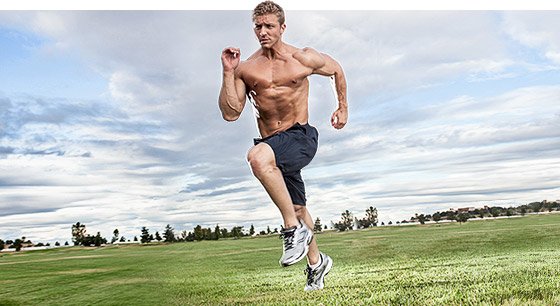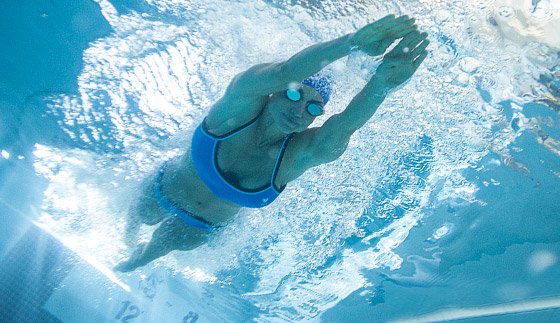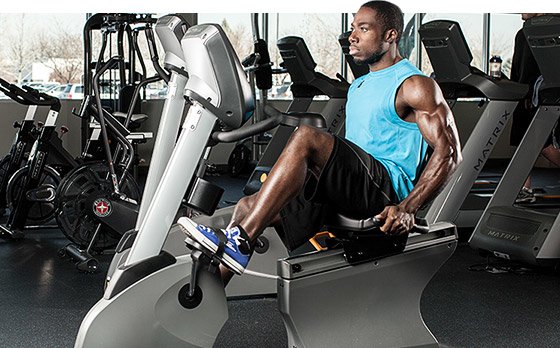Both the anaerobic and aerobic power systems are important to the athlete and each need to be trained to optimize athletic performance. This article will discuss the different methods used to train both systems in order to increase the anaerobic and aerobic capacity of an athlete.
Training Power Systems
Both the anaerobic and aerobic systems are utilized during training and athletic performance. The extent to which each system is used depends upon the activity or sport participated in, and they will all fall along an Energy Continuum.
Therefore the athlete has to ensure that they train both power systems to maximize their athletic performance. This article will discuss the different methods used to train both systems in order to increase the anaerobic and aerobic capacity of the athlete.
The Anaerobic System

The anaerobic system is utilized in all-out efforts of exercise lasting up to one minute. There are two anaerobic power systems available to the body:
- The Adenosine Triphosphate-Creatine Phosphate (ATP-CP) system, and
- The anaerobic glycolysis/lactic acid system.
The ATP-CP system is used for efforts lasting less than 10 seconds; while the anaerobic glycolysis system powers efforts longer than 10 seconds, lasting up to a few minutes (McArdle, Katch & Katch, 1991).
Anaerobic Training
Anaerobic training enhances the anaerobic metabolic capacity of the muscle fibres that are being trained, thus increasing the ability of the athlete to train, and therefore perform at higher exercise intensity (McArdle et. al., 1991).
Anaerobic training is achieved through:
- Sprint (speed), and/or
- Power training.
Through maximal interval training sprint and power training works by overloading the ATP-CP and/or anaerobic glycolysis/lactic acid system. The specificity of training principle - It is best for training to simulate the movements and energy demands of the sport of the athlete (Harman and Pandorf, 2000) - applies to anaerobic training; the muscles that require enhanced anaerobic and ATP-CP energy capacity must be the muscles working during anaerobic training; and anaerobic training must be done at the speed that the athlete wants to perform at (McArdle et. al., 1991).
High Intensity Interval Training
High intensity interval training (HIIT) with short intervals of 10-15 seconds at 90-100% of maximum heart rate, with rest/recovery periods of 30-60 seconds (i.e. recovery periods should be three times as long as the effort), trains the ATP-CP system.

HIIT increases the muscle's resting levels of ATP-CP. It is also responsible for neuromuscular changes in the rate and pattern of the movement performed by recruiting the motor units used during training (McArdle et. al., 1991).
Interval Training
Interval training with all out efforts greater than 10 seconds, usually lasting one minute at 90-100% maximum heart rate, with rest/recovery periods of 3-5 minutes (i.e. recovery periods are twice as long as the effort) trains the anaerobic glycolysis/lactic acid system.
Metabolic changes that occur through this type of interval training include an increased tolerance to lactic acid, as the specific muscles working keep building up with lactic acid (McArdle et. al, 1991).
How Does Anaerobic Training Increase Anaerobic Capacity?
Anaerobic training increases anaerobic capacity through a number of different ways, including:
- Increasing the athlete's lactate tolerance;
- Increases the size of the fast twitch muscle fibres;
- Increasing the resting levels of ATP, Creatine Phosphate, free Creatine and glycogen in the muscles (McArdle et. al., 1991)
A higher anaerobic capacity enables an athlete to:
- Perform at a higher intensity over a specific distance,
- Maintain a high intensity for a longer period of time, or
- Maintain either the same or a higher intensity over a further distance (McArdle et. al, 1991).
Anaerobic training should be included at the end of Phase 1 of the Training Phases (See footnotes), so that the athlete is not fatigued for their aerobic and/or conditioning training (McArdle et. al., 1991).
The Aerobic System
The aerobic system, also known as aerobic glycolysis, powers continuous steady state exercise longer than three to four minutes. In the aerobic system energy (ATP) is produced through Pyruvic Acid and Lipid/Protein fragments entering the Kreb Cycle and the Electron Transport Cycle (McArdle, 1991).
Aerobic glycolysis is dependent upon the athlete's aerobic capacity, which is their functional capacity for oxygen transport (i.e. distribution of oxygen rich blood to body tissues) and utilization (i.e. ability of muscle to use available oxygen to produce energy). Aerobic training increases aerobic capacity through adaptations to the athlete's oxygen transport and utilization systems (McArdle et. al., 1991).
Aerobic Training
Aerobic training must be specific to the athlete's sport; and it must provide a sufficient cardiovascular overload to stimulate increases in the athlete's stroke volume and cardiac output.

Using the specificity of training principle, cardiovascular overload should be accomplished by concurrently enhancing the local circulation of the appropriate muscle groups (McArdle et. al., 1991), by performing aerobic exercise that best mimics the movements used during the athlete's athletic performance.
Aerobic training increases fitness and is achieved through:
- Interval training,
- Continuous training (this must be intense enough to overload the aerobic system), and
- Fartlek training (McArdle et. al., 1991).
Interval Training
Interval training allows the athlete to perform high intensity, intermittent exercise for a long period of time. To train the aerobic system the recovery periods of interval training should be at a ratio of 1-1.5:1 to the effort intervals.
The recommended recovery is not enough time for complete recovery; this is so that the athlete's aerobic system is stressed, so that circulatory and metabolic adjustments are made to increase their body's aerobic capacity (McArdle et. al., 1991).
Continuous Training
Continuous training is long, slow, steady, submaximal training at a moderate to high intensity of 60-80% of maximum oxygen capacity (i.e. VO2) and/or maximum heart rate. Continuous training is 'over-distance' training that allows the athlete to train at the same intensity as they would if they were competing.

"It is believed that over-distance training produces the largest aerobic adaptations in both the central and peripheral tissues. Overload is generally accomplished by increasing exercise duration, although the work rate increases progressively as training improvements are achieved" (McArdle et. al., 1991, p.444); meaning that as the athlete becomes aerobically fitter they can train at a higher intensity for longer.
Fartlek Training
Fartlek training is a form of interval training (and develops all energy systems, not just the aerobic system!). Instead of using percentages of heart rate or maximum oxygen capacity to determine the intensity of the effort intervals fartlek training allows the athlete to perform their efforts based on how they 'feel' at that particular time during training.
Although Fartlek training lacks the systematic and quantified base of interval and continuous training, it is ideally suited for the athlete's general conditioning or off-season training, allowing them to incorporate a bit of variety in their training (McArdle et. al., 1991).
How Does Aerobic Training Increase Aerobic Capacity?
Aerobic training increases the athlete's aerobic capacity through adaptations to the athlete's oxygen transport and utilization systems, including:
- Increasing the quantity of oxygen in the working muscles' cells, which increases the capacity of the mitochondria in the working muscles to uptake and process oxygen to produce ATP; and
- Increasing the mitochondria in working muscles (McArdle et. al., 1991).
Because of this there is an increase in oxygen rich blood to the muscles; therefore the working muscles have an increased ability to mobilize and oxidize fat, and thus have an increased ability to oxidize carbohydrate. As anaerobic training increases the size of the fast twitch muscle fibers, aerobic training increases the size of the slow twitch muscle fibres (McArdle et. a., 1991).
The aerobic system needs to be trained at least three times per week for a period of 30-to-60 minutes (or more) (McArdle et. al., 1991).
Conclusion

There are two anaerobic power systems: The ATP-CP system is used for efforts lasting less than 10 seconds; the anaerobic glycolysis system is used for efforts lasting up to a few minutes. Anaerobic training is achieved through sprint (speed) and/or power training (McArdle, et. al, 1991), by overloading the ATP-CP and/or anaerobic glycolysis/lactic acid systems through maximal interval training.
Anaerobic training increases the athlete's anaerobic capacity by increasing their lactate tolerance, the size of the fast-twitch muscle fibers, and the resting levels of ATP, Creatine Phosphate, free Creatine and glycogen in the athlete's muscles.
The aerobic system is used to power steady state exercise of continuous duration of longer than 3-to-4 minutes. Aerobic capacity is increased through interval training, continuous training (this must be intense enough to overload the aerobic system), and fartlek training. Aerobic training increases aerobic capacity through adaptations to the athlete's oxygen transport and utilization systems.
Both the anaerobic and aerobic power systems are important to the athlete ad each needs to be trained to optimize their athletic performance.
References
- Harman, E. & Pandorf, C. (2000). Principles of test selection and administration. In T. R. Baechle & R. W. Earle (Eds.). Essentials of strength training and conditioning (2nd ed.) (p. 275-286). Hong Kong: Human Kinetics.
- McArdle, W. D., Katch, F. I. & Katch, V. L. (1991). Exercise physiology: Energy, nutrition and human performance (3rd ed.). United States of America: Lea & Febiger.
Recommended For You

8 WAYS TO GET SPARTAN STRONG!
Everyone wants to be fitter, happier, healthier, and more successful. Making it happen requires you to step outside of your comfort zone. Let the co-founder of Spartan Race show you how!
FITNESS PERSONALITY TEST
What's your fitness personality type? Take our quick quiz to find out! Uncover your fitness hurdles, share with your friends, and get fit for life.
